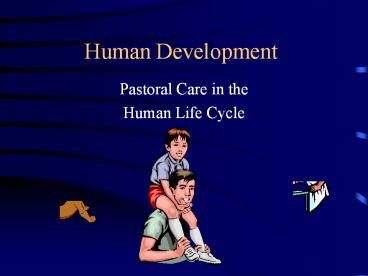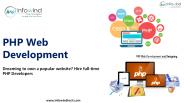Human Development - PowerPoint PPT Presentation
1 / 30
Title:
Human Development
Description:
Stages are constructed based upon the inter-relationships of seven aspects: Form of Logic ... is not the stepfamily per se, but parental conflict left over from ... – PowerPoint PPT presentation
Number of Views:70
Avg rating:3.0/5.0
Title: Human Development
1
Human Development
- Pastoral Care in the
- Human Life Cycle
2
Development A Biblical Perspective
- When I was a child, I talked like a child, I
thought like a child, I reasoned like a child.
When I became a man, I put childish ways behind
me. (I Cor. 1311) - Therefore let us leave the elementary teachings
about Christ and go on to maturity . . . . And
God permitting, we will do so. (Heb. 61a, 3) - Train a child in the way he should go, and when
he is old he will not turn from it. (Prov. 226)
3
Communicating the Gospel at the Point of Need
4
Faith Development
- James Fowler identifies a series of distinct,
identifiable stages which characterize the way
that people make meaning of life. He treats
faith as a generic human phenomenon, though he
acknowledges Christian faith as a modification of
meaning-making toward God. Describes one
pre-stage and six stages in the sequence of faith
development.
5
Fowlers Stages of Faith Development
- Adopts a structuralist-developmental view using
important concepts from - Erik Erikson (psychosocial development)
- Jean Piaget (cognitive development)
- Lawrence Kohlberg (moral development)
- Paul Tillich (theologian)
- Richard Niebuhr (theologian)
6
Basis of Fowlers Stages
- Stages are constructed based upon the
inter-relationships of seven aspects - Form of Logic
- Role-taking
- Form of Moral Judgment
- Bounds of Social Awareness
- Locus of Authority
- Form of World Coherence
- Symbolic Functioning
7
Fowlers Stages of Faith Development 2
- Pre-stage - infancy undifferentiated faith
- Stage 1 - Intuitive-Projective faith
- Stage 2 - Mythic-Literal faith
- Stage 3 - Synthetic-Conventional faith
- Stage 4 - Individuative-Reflective faith
- Stage 5 - Conjunctive faith
- Stage 6 - Universalizing faith
8
Temp Sparkmans Faith Development Perspective
9
(No Transcript)
10
Temp Sparkmans Faith Development Perspective 3
11
Temp Sparkmans Faith Development Perspective 4
12
Piagets Cognitive Developmental Theory 1
- Based upon
- organismic (active) view of human beings
- developmental (rooted in genetics pattern
capacity for growth) view of biology - structural (active, subjective transformation and
construction of ones understanding of the world)
view of human intelligence
13
Piagets Cognitive Developmental Theory 2
- Sensori-motor Stage (0-2 yrs) object permanence
develops - Pre-operational Stage (2-7 yrs) egocentrism,
classification conservation problems, animism - Concrete Operations Stage (7-12 yrs) good
conservation operations, unable to deal with most
abstract concepts - Formal Operations Stage (11-12 yrs) adult
reasoning, can think abstractly
14
Erik Eriksons Psychosocial Developmental Theory
- Epigenetic - first the blade, then the ear, then
the full corn shall appear (Mk. 428) Kingdom
of God - plan, process - Involves a major psychosocial crisis in the
course of development both as the social sphere
widens and physical/mental maturation occurs - Each stage has pos./neg. outcome no crisis ever
completely solved perennial themes - Eriks son
15
Everybody Rides the Carousel
- Video
16
Family Life Cycle Stages
- 1) Leaving Home
- 2) Joining Families through Marriage
- 3) Families with Young Children
- 4) Families with Adolescents
- 5) Launching Children Moving On
- 6) Families in Later Life
17
Family Life Cycle
18
Marital Life Cycle
- Marital Satisfaction is typically
- Highest prior to birth of children
- Lowest for husbands while children are
adolescents - Lowest for wives just after empty nest but before
retirement - These are descriptive, not prescriptive!!
- 85 divorce rate among couples who have had a
child to die.
19
Family Systems Theory
- Sees and responds to problems within the context
of the larger system - Does not remove individual accountability and
responsibility - Considers that the presenting problem may be a
symptom of a system problem (marital or family
system)
20
Step Families
- The Struggle to Be
21
Definitions
- A stepfamily is a household in which there is an
adult couple, at least one of whom has a child by
a previous relationship. Sixty-five percent of
stepfamilies resulting from divorce have children
living with their biological mother. - Step - comes from the old English steop
meaning orphaned or bereaved.
22
How Stepfamilies Are Formed
- Up until about the 20th century, the primary
reason for the creation of a stepfamily was the
death of a parent. - Today, the number one reason is divorce.
- Loss grief are inherent in both.
- Stepfamilies create relationships in which a
parent is related to a child only by marriage,
not by blood.
23
Virginia Rutter, Lessons from Stepfamiles,
Psychology Today, 27 (3), May-June 1994, 30.
- In 2000, stepfamilies will outnumber all other
family types - Stepfamilies experience most of their troubles in
the first two years - What trips up stepkids is not the stepfamily per
se, but parental conflict left over from the
first marriage (lack of time attention from
parents) - 80 no long-term behavior problems compared to
90 in first marriage families
24
Basic Differences in SF Structure 1
- The Family Begins after Many Losses Changes
- Both Adults Children Come Together with
Incongruent Individual, Marital, Family Life
Cycles - Children Adults All Have Expectations from
Previous Families - Parent-Child Relationships Predate the New Couple
Relationship - There is a Biological Parent in Another Household
or in Memory
25
Basic Differences in SF Structure 2
- Children Often Are Members of Two Households
- There Is Little or No Legal Relationship Between
Stepparents and Stepchildren - Dealing with these structural differences
requires that certain tasks be accomplished for
satisfactory family integration to occur.
26
Stepfamily Integration Tasks
- Dealing with Losses Changes
- Negotiate Different Developmental Needs
- Establish New Traditions
- Developing a Strong Couple Bond
- Forming New Relationships
- Creating a Parent Coalition
- Accepting Continual Shifts in Household
Composition - Risking Involvement Despite Little Support from
Society
27
Integration TimeframeVisher Visher, 49.
28
Most Common Areas of SF Difficulty Usually
Created by External Structural Characteristics
- Change Loss
- Unrealistic Beliefs or Expectations
- Insiders/Outsiders
- Life-Cycle Discrepancies
- Loyalty Conflicts
- Boundary Problems
- Power Issues
- Closeness/Distance
29
Typical Problem Areas
- Divided Loyalty - child to parents child to
stepparent grandparents too parent to
child/stepchild spouse to spouse. - Discipline of Children/Stepchildren
- Financial Dilemmas - support insurance college
tuition estate problems - Differing Places Along the Life Cycle
- Relating to strangers
30
(No Transcript)































